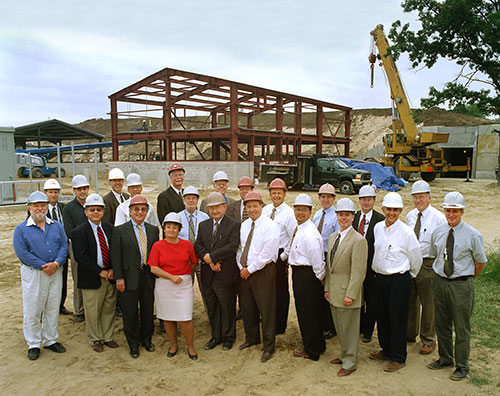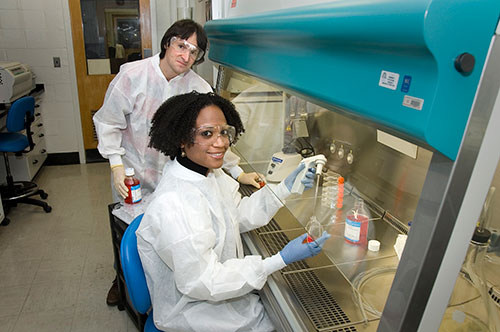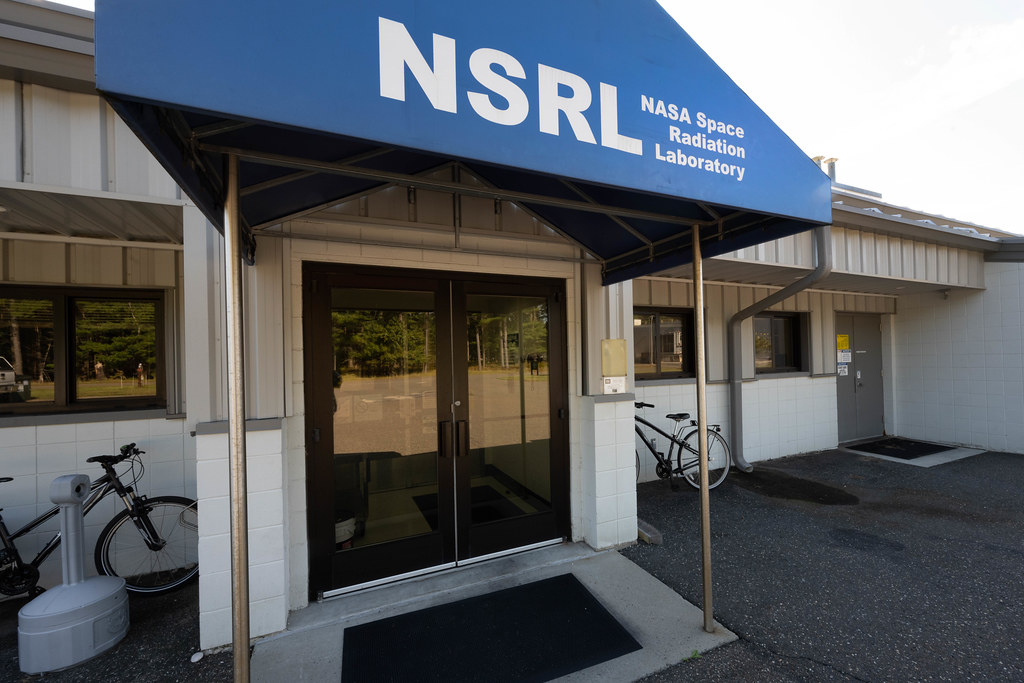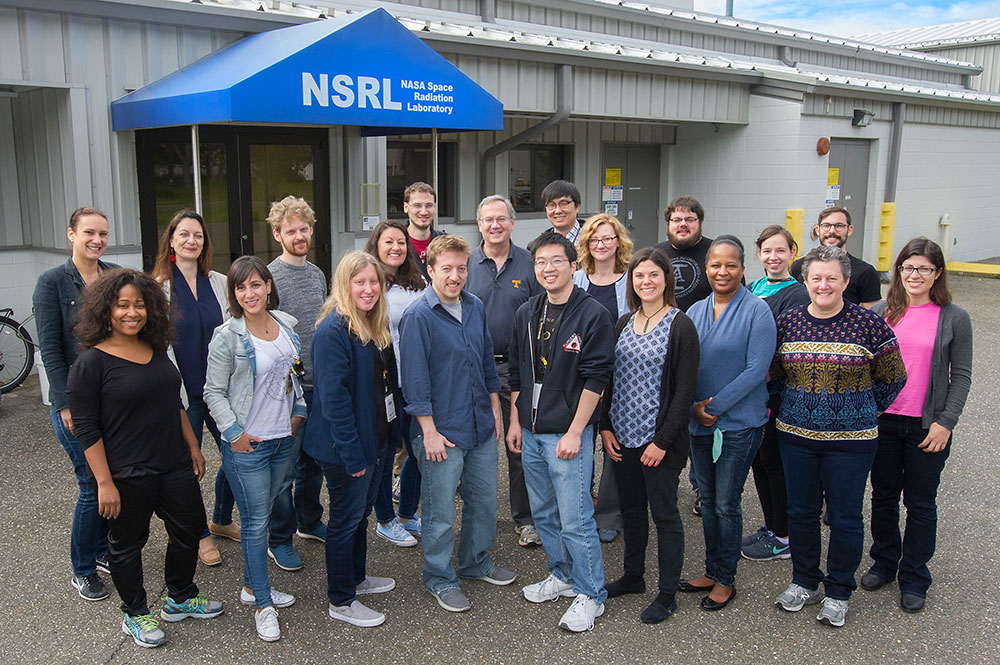20 Years of Research at the NASA Space Radiation Laboratory
Extensive experiments have reduced uncertainty about risks to astronauts, expanded our understanding of cancer, and opened new avenues for testing electronics
October 16, 2023
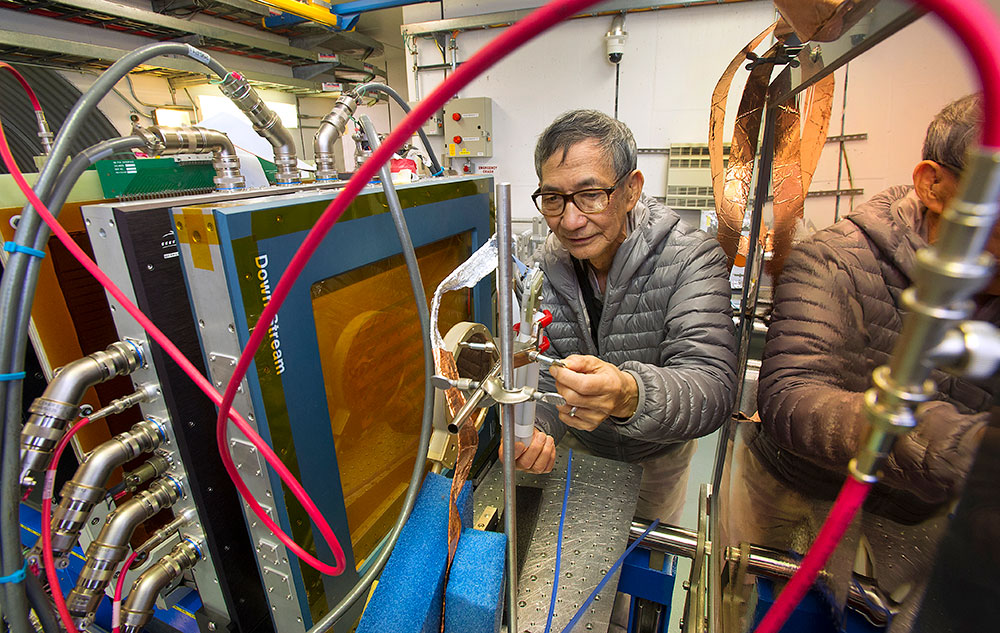 enlarge
enlarge
I-Hung Chiang, one of the early liaison physicists at the NASA Space Radiation Laboratory (NSRL) at Brookhaven National Laboratory.
Twenty years ago, on Oct. 14, 2003, dignitaries gathered to declare the NASA Space Radiation Laboratory (NSRL) open for experiments. The NSRL facility, built by NASA at the U.S. Department of Energy’s (DOE) Brookhaven National Laboratory, makes use of powerful particle beams to simulate the effects of space radiation. At its start, it had one straightforward goal: Help scientists understand the risks astronauts would face during long-term missions to the moon or Mars.
“Radiation has largely been seen as one of the biggest challenges for a crewed mission to Mars,” said Brookhaven Lab’s Peter Guida, the NSRL liaison biologist. “Getting to Mars is not only about the mechanical challenges and the engineering; NASA is concerned about cancer, the effects of radiation on the central nervous system, and other degenerative risks to body tissues like the heart and gastrointestinal tract.”
NASA wants to reduce those risks to levels deemed acceptable to allow astronauts to go to Mars. But first, scientists need to characterize the complex reactions that different types of space radiation may bring about on various biological systems. Knowing the real numbers—and designing strategies to protect astronauts—is key.
Now, celebrating 20 years of operations, NSRL scientists say a lot of progress has been made.
“To date, more than 1,600 NASA experiments have been conducted and NSRL remains NASA’s premier facility to conduct biomedical space radiation research,” said Lisa Simonsen, a senior scientist in NASA’s Human Spaceflight Capabilities Division and NASA’s manager for NSRL. “Results from these ground-based experiments are being used to develop strategies to mitigate crew health risks and maintain high levels of human performance on long duration missions.”
Reducing uncertainty
“The main challenge in estimating the health risks posed by space radiation is understanding the large biological uncertainty about that risk,” said Brookhaven Lab physicist Michael Sivertz, NSRL principal investigator. “The research we’ve done here has helped us define the risk much better and develop an understanding of how to best protect a crew.”
That progress has come from running many experiments exploring how energetic particles (from protons to iron ions) affect a wide range of model systems—DNA, cell cultures, sci-fi-sounding “organs on a chip,” and rodent models. And with upgrades to Brookhaven Lab’s accelerator infrastructure, physicists can now switch the ion species delivered to NSRL’s target area every two to three minutes. That rapid switching delivers a mix of ions that more closely mimics the energetic particles zipping through space.
“There is no other facility in the world that can do this,” Guida said, extolling the “Galactic Cosmic Ray Simulator” as NSRL’s biggest advance.
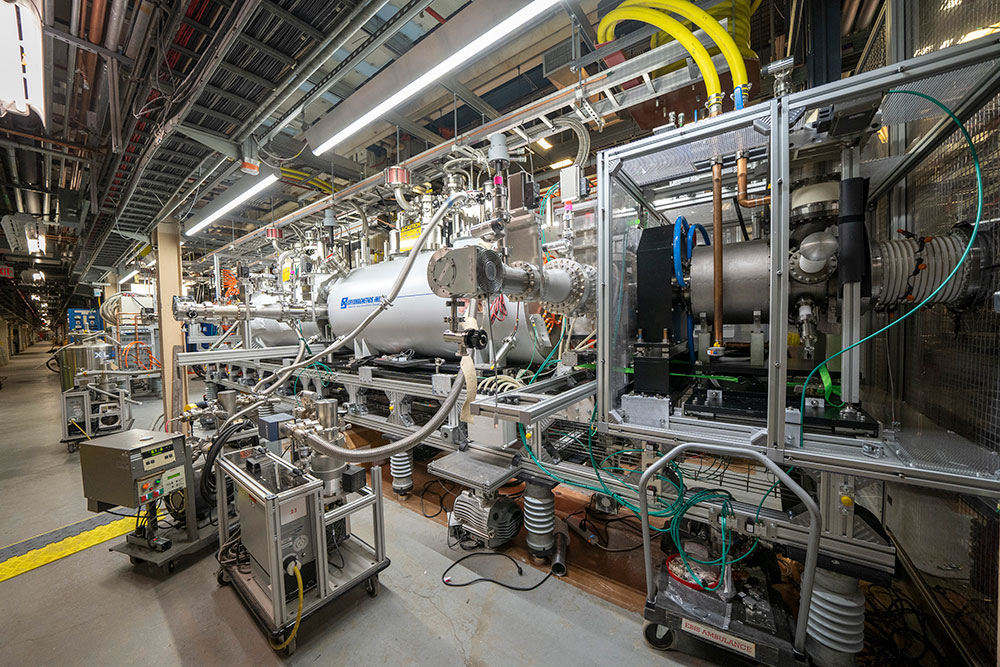 enlarge
enlarge
The Electron Beam Ion Source allows physicists to rapidly switch the ion species delivered to NSRL's experimental end station to more closely simulate the range of ions present in galactic cosmic rays.
Using these capabilities, scientists have run ever-more sophisticated experiments, including tests of a wide range of countermeasures that could help prevent, mitigate, treat, and rehabilitate potential spaceflight-induced health problems.
“With more and more data, we can piece it all together with mathematical equations and modeling to extrapolate from cells in a dish or a mouse to a human system so that NASA—as an employer of astronauts—can say, ‘we have a very good idea of what this means,’” Guida said.
“And I think we are getting closer,” he said. “A combination of a few countermeasures may be enough to get NASA under its threshold of acceptable risk, at least from a radiation perspective, to launch a crewed mission to Mars.”
Benefits beyond the final frontier
The research at NSRL is not just for the benefit of a few astronauts seeking to go where no human has gone before.
“NASA’s mission statement is to make life better for humans as a whole, not just in space travel,” Guida said. “A lot of what goes on here provides a basic mechanistic understanding of how some diseases like cancer come about.”
In fact, Sivertz noted, “Many of the scientists at NSRL have come here for their sole interest in understanding and treating cancer on Earth and to use the facility to explore the potential of new forms of radiation treatments.”
Studies at NSRL revealed that massive particles such as protons and carbon ions can deliver more powerful knockout punches to tumors than conventional x-rays or gamma rays, which both lack mass and charge.
And all those tests of countermeasures to mitigate damage from space radiation might also inform strategies for protecting healthy tissues in patients undergoing radiation treatment.
In addition, over the years, a whole new and growing user community has come to NSRL to test the effects of space radiation on sensitive electronics—like those used in satellites and computers, both in space and here on Earth.
“Think about how many systems run off satellites that are in some sort of radiation environment in orbit—the GPS on our phones and in our cars, telescopes, and more,” Guida said.
With more sophisticated electronic systems and growing demand to test them, NASA agreed to allow non-NASA testing at NSRL. Since then, “We’ve had users from the space industry, other government agencies, and a surprising number of small independent testers,” Sivertz said.
Guida noted the rationale for these studies: “Given the enormous cost to build and launch a satellite, you’d want to do a certain amount of ground-based testing to make sure it can withstand the space environment, so it has a longer life.”
A look back
The idea for such ground-based radiation testing dates back long before the opening of NSRL.
“The alternative to doing this type of research on the ground is to do all flight-based experiments,” Guida said.
Sending cells into orbit may be a more real-world scenario, he noted, but with a flight-based mission, there may only be one launch opportunity in a year. Plus it’s extraordinarily expensive and the size of the spacecraft limits the number of samples available for testing.
So even from the early days of the space program, NASA was interested in finding a ground-based particle accelerator that could supply the range of ions found in space at near-light-speed energies. For a long time, they used what they could get, first at the Princeton Particle Accelerator and the Bevatron at DOE’s Lawrence Berkeley National Laboratory, and beginning in 1995, the Alternating Gradient Synchrotron (AGS) at Brookhaven. All these facilities were primarily dedicated to physics research exploring fundamental particles. The radiobiology research fit in around the “edges.”
“Those early days, we ran beam 24 hours a day, seven days a week at the AGS. When you ran into a machine issue or something, everyone downstream got thrown off,” Guida said.
Plus the experimental building was something like an airplane hangar—cavernous with terrible lighting and non-existent temperature control. “And there were horns going off all the time,” Sivertz recalled.
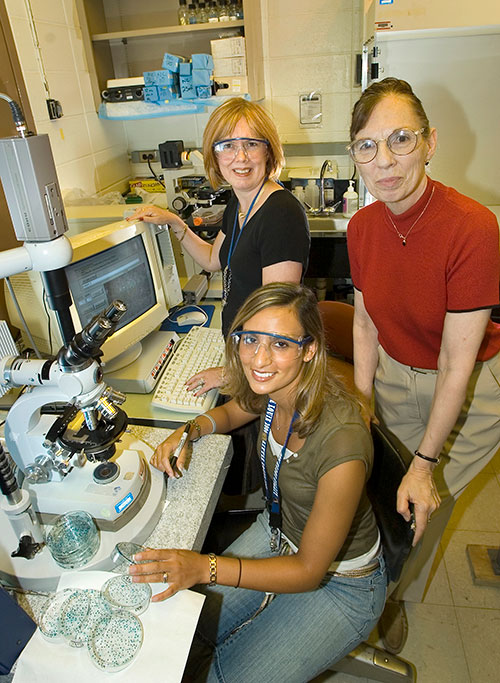 enlarge
enlarge
Betsy Sutherland, right, was one of the pioneers of research at NSRL, shown here with Paula Bennett (rear) and Noelle Cutter Cuomo.
Meanwhile, NASA had been exploring plans to build its own facility. A Brookhaven plan to build NSRL off the Booster accelerator that feeds beams to the AGS was spearheaded by Walter Schimmerling, a program scientist at NASA at the time, along with Derek Lowenstein, then the chair of Brookhaven Lab’s Collider-Accelerator Department, and renowned Brookhaven Lab radiobiologist Betsy Sutherland, now deceased.
In the late 1990s, as the mission of the AGS was changing to become a pre-accelerator of beams for the nearly completed Relativistic Heavy Ion Collider (RHIC), the Brookhaven plan was approved.
Construction of the tunnel housing the beamline that now carries accelerated particles from the Booster to NSRL began in earnest in January 2000. The first beam went through to the target area in the summer of 2003, striking flasks containing cell cultures placed there by Sutherland. She would later analyze the cells to check for DNA damage. The second experiment, also that summer, was run by Guida and Marcelo Vazquez, who served with Sutherland as a liaison biologist in the facility’s early years.
“We just wanted to make sure that cells were getting exposed, that changes were happening, and that we could detect those changes,” Guida said. “These experiments gave us the evidence we needed for early validation of the beamline.”
NASA then opened the facility that fall to the first external users whose research proposals had been approved, many of whom had been earlier users of the AGS beams.
Kathryn Held, a radiation oncology researcher at Massachusetts General Hospital, associate professor at Harvard Medical School, and president of the National Council on Radiation Protection and Measurements, recalled how she’d tagged along with Betsy Sutherland for experiments at the AGS and then became one of the first users at NSRL.
“In the early days and ever since, the ‘can-do’ attitude of the staff has been the cornerstone to the achievements at NSRL,” she said. “It is so much more than just a physical facility.”
For example, she noted that her team requested extremely low densities of particles in the beams, “including a way to know the exact numbers.” The reason? “In deep space, the charged particles from galactic cosmic rays (GCR) going through an astronaut's body will be widely spaced in location and time, so any given single cell will not get a particle traversal very often. We wanted to simulate that.”
This “low fluence” had not been achieved in previous space radiation research, Held said, “but the NSRL physics team figured out how to do it.”
In addition, Held recalled how fairly early on, her team and Betsy Sutherland’s requested not just beams of single ions, but two different ions in quick succession. “The physics team gave us protons and iron ions within minutes of each other—a feat that eventually evolved into the fantastic 33-ion galactic cosmic ray simulator now available,” she said.
Charged particles may be small, but they matter to astronauts. NASA's Human Research Program is investigating these particles to solve one of its biggest challenges for a human journey to Mars: space radiation and its effects on the human body. (Credit: NASA EDGE)
Evolving knowledge
Summarizing all the findings that have come out of NSRL would fill a hefty volume. But a few key points have emerged.
“One of the first hypotheses was that space radiation would induce more complex types of DNA damage in cells, and that damage would be more difficult to repair,” Guida said. “That’s proven to be true.”
The reason is that life on Earth has had four and a half billion years to learn how to deal with constant bombardment by the cosmic rays that reach the planet’s surface: mostly lightly ionizing particles such as muons. Over millennia, the life forms that could repair the damage caused by these particles are the ones that survived.
“But because we’re protected by the atmosphere and the planet’s magnetic field, our cells have never seen the highest energetic heavy ions of galactic cosmic rays. So they don't know how to repair that kind of damage,” Sivertz explained. “That's what makes space radiation so different and so dangerous.”
In addition, the level of damage depends not just on the dose of radiation, but more so on the types of particles and the duration and frequency of the exposure.
“Physicists can measure the dose with scintillation counters and ion chambers very precisely,” Guida said. “But that same dose will do very different things depending on what kind of charged particle delivers that dose. In general, the heavier the ion, the greater the biological damage.”
Think about the difference between dropping a pound of feathers and a pound of lead on your foot. “You might barely notice something when dropping the feathers, but if I dropped the pound of lead, it might break several toes,” Guida said. “So, a dose of massless x-rays is very different than a dose of iron particles, even though it’s the same dose.”
The experiments at NSRL have always aimed to deliver what NASA calls a “mission-relevant” dose for crews in deep space or on the moon or Mars. These doses are based on their knowledge of the types and levels of radiation detected by observational satellites, detector systems on the International Space Station, and uncrewed missions to the surface of Mars.
“NASA knows what the dose is going to be and even what the particle spectrum will be. But what does that spectrum of particles and dose mean to a human being on a real Mars mission?” Guida asked.
The Galactic Cosmic Ray Simulator can recreate the mix of ion species and energies. But scientists must scale the exposure time for the lifecycle of whatever sample they are studying to try to find an answer.
“When a year of radiation is delivered in one minute, the repair mechanisms in your body may not have the chance to conduct their repair before the next damage is done,” Sivertz said. “So, the GCR experiments are conducted for an hour every morning for six weeks, which is closer to the type of exposures that are going to be experienced by an astronaut over the course of a two- to three-year mission to Mars.”
Gregory Nelson of Loma Linda University, one of the first researchers at NSRL, noted, “Without the NSRL team of operators and beamline improvements to enable the GCR Simulator, these studies would not have been possible.”
However, Simonsen noted, “Key challenges remain—both technical and biological—in simulating the chronic low dose rates found in space and translating those experimental results to humans.”
Paula Bennett holds cell-culture flasks to be inserted into the NSRL beamline. Hover over image to reveal controls for a slideshow of more NSRL photos.
Sophisticated experiments
As the NSRL accelerator has evolved, the experiments have also gotten more sophisticated.
For example, instead of exposing one cell type in a dish, scientists now can study collections of cells from a particular organ system—so-called “organs on a chip.”
“It’s like a microscope slide with four or five different cell types in there that all signal to each other so you get a kind of interchange among them, like in a real body,” Guida said.
“You can see the heart cells beating,” Sivertz said.
“And they’re in unison, even though it’s not a heart,” Guida added. “Are these affected the same as when we just looked at cardiac cells in isolation? Or is it different when they are functioning like a beating organ?” he asked.
These questions are important because in a real human body there are interactions not just among cells of a single system, but across systems as well.
“Brain cells in a dish are not a brain,” Guida said. “And that doesn’t feed back into a whole organism. We have immune cells that get involved. But when researchers look at brain cells in a dish, there’s no immune system in there. It’s a lot to piece together.”
Researchers are also interested in understanding which astronauts may be at a higher risk of developing space-radiation-induced cancers and whether these cancers are the same as cancers arising from gamma radiation.
“Our studies have given us a better understanding of the key role played by naturally occurring genetic variations between individuals in determining their susceptibilities to space radiation-induced cancers,” said Michael Weil, a professor of environmental and radiological health sciences at Colorado State University, who has led research teams at NSRL over the past 20 years. Through a combination of experiments on model systems and extrapolation, “we have also shown that the types of cancers and leukemias resulting from heavy ion exposures are similar to those produced by gamma rays.”
Simonsen noted that these results are important to improve and validate risk models. “In the future, we can use results such as these to better understand which crew may be most susceptible to radiation and give them added protection on the way to Mars,” she said.
Understanding the risk for developing cardiovascular disease after exposure to space radiation is also a high priority.
“By using multiple research models, our team has identified only small changes in heart function and the tissue structure of heart and blood vessels,” said Marjan Boerma of the University of Arkansas, Little Rock, who has been an NSRL user for the past eight years. This would be good news for NASA if the risk for cardiac and vascular diseases remains low.
Still, much of the research using model systems suggests that, after a long mission, astronauts are likely to have a higher risk of developing certain cancers, degenerative tissue effects, and other long term health consequences.
“Results from all these NASA-funded research teams and epidemiological studies will ultimately develop the evidence base we will use to quantify these long-term risks,” Simonsen said.
NSRL results also suggest that that astronauts could face short-term risks from radiation, such as impaired cognitive function and disrupted emotional status.
“While the astronauts are up there, could they suffer some cognitive impairments that make it difficult to operate the machinery—a robotic arm or the sample collectors—or to work effectively together as a team, or even pilot the spacecraft during critical maneuvers? That would be a problem,” Guida said.
Blocking the damage
Having identified and narrowed the uncertainty about the main radiation risks, the logical progression of research at NSRL has been to explore countermeasures to bring these risks down.
One of the most promising countermeasures appears to be antioxidants. Guida explained the rationale: The heavy ions that make up galactic cosmic rays break water molecules apart, creating reactive oxygen radicals. “But if your system is primed with antioxidants, they have a way of negating the damage,” he said. “The ions would still cleave the water molecule, but the antioxidants are sitting there ready to try to neutralize those reactive oxygen species.”
He described one famous NSRL experiment where rats that were fed a blueberry smoothie before getting a mission-relevant radiation dose could find their way through a previously memorized maze better than rats that didn’t get the antioxidant-rich shakes. Shielding around the spacecraft could also play a protective role, and studies at NSRL have pointed out the relative strengths of simple water.
“If you were protecting against photons, such as gamma rays, lead would be a great choice,” Sivertz said. “But you’re not. You’re protecting against things like iron nuclei, which would produce a lot of secondary radiation from nuclear interactions in lead—including a large number of neutrons that are very biologically damaging.”
Water, on the other hand, because of its high hydrogen content, can more effectively minimize the number of secondary particles and neutrons produced from iron, he noted.
“Plus, the astronauts need to bring water with them anyway, so why not use it as shielding within the spacecraft,” Sivertz suggested.
Planning for the future
Studies of combinations of countermeasures are ongoing to see if risks can be reduced enough to meet NASA’s thresholds.
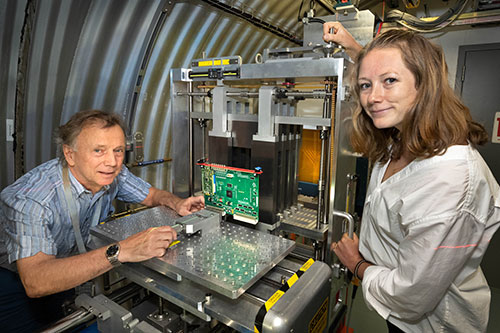 enlarge
enlarge
Michael Sivertz and Jessica Gasparik install a circuit board in the beamline at NSRL to test the electronic system's response to a radiation environment.
Meanwhile, on the electronics front, testing is gearing up.
In the early days, most electronics testing was putting a single chip in a beam and exposing it and seeing how it responded—somewhat like the studies of single cell cultures.
“Now we have the capability of putting an entire system in the beam—a flight navigation system, a full computer, or an integrated circuit board—to see how it operates when exposed to radiation,” Sivertz said.
The importance of that testing is only growing as electronics find their way into more and more aspects of daily life and society becomes more dependent upon them. So, as the questions about risks to astronauts are being answered, the NSRL scientists are thinking about the future.
“NSRL has been a great workshop for learning about electronics testing,” Sivertz said. “Maybe it will serve as the protype for a new dedicated, high-energy electronics testing facility that we would like to build, back at the AGS.”
Next generation
Physicists and biologists—both at Brookhaven and at NASA—have also been thinking all along about training the next generation to carry on their work.
“This isn’t something you learn in your Ph.D. program,” Guida said. “We’ve always had to think about where the pipeline of new investigators is going to come from.”
He credits NASA for developing a summer school program early in NSRL’s days that provided coursework and hands-on experience designing and running charged-particle radiation experiments.
“A lot of the participants were postdocs and graduate students in the labs of the scientists who had NASA grants to come to NSRL for their research,” Guida said. “It was extraordinarily successful in that the majority of people who signed up for it stayed in the field, and a significant number went on to obtain grant funding, which is huge.”
“We developed our own successors,” Sivertz added.
Though that NSRL summer school program was suspended in 2017, and then the COVID pandemic put the brakes on a restart, NASA launched a more recent, mostly virtual program called SHINE (Space Health Impacts for the NASA Experience). NASA is hopeful that the best performers from that program will come to Brookhaven for hands-on training again in the fall of 2024.
Meanwhile, a subgroup of NSRL electronics testers conducted a summer school in March 2022 to help develop the next cohort to carry on their important mission.
“An impressive amount of data and understanding has been generated through experiments at NSRL over the past 20 years, but there are always more questions to ask. That is the beauty of science,” said Guida, who is looking forward to the next 20 years.
NSRL is part of Brookhaven Lab’s Collider-Accelerator Complex and operates symbiotically with the Lab’s nuclear physics research program at the Relativistic Heavy Ion Collider (RHIC). RHIC is funded by the DOE Office of Science and operates as an Office of Science user facility for collaborators from around the world.
Brookhaven National Laboratory is supported by the Office of Science of the U.S. Department of Energy. The Office of Science is the single largest supporter of basic research in the physical sciences in the United States and is working to address some of the most pressing challenges of our time. For more information, visit science.energy.gov.
Follow @BrookhavenLab on social media. Find us on Instagram, LinkedIn, Twitter, and Facebook.
2023-21491 | INT/EXT | Newsroom




